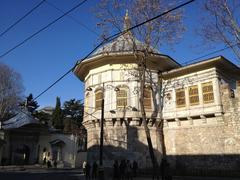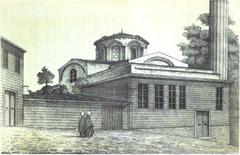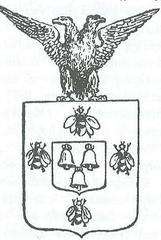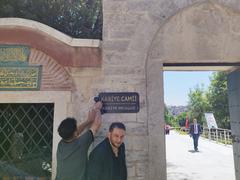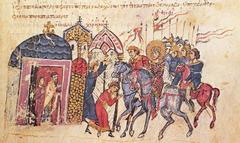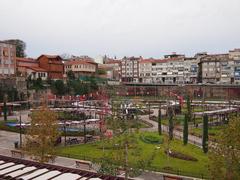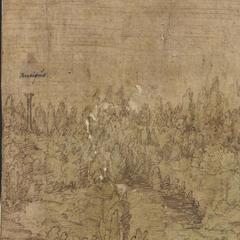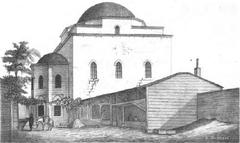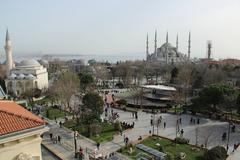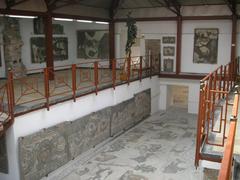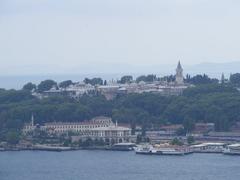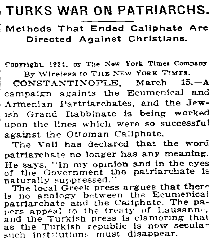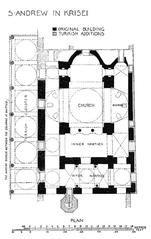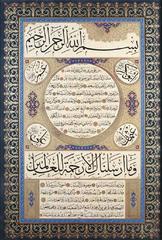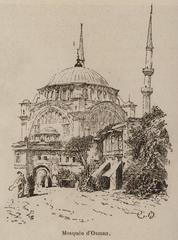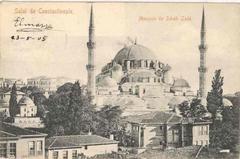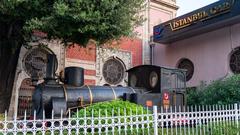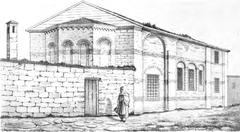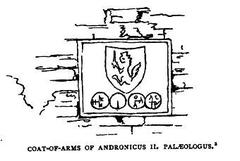Armenian Patriarchate of Constantinople: Visiting Hours, Tickets, and Historical Significance in Fatih, Turkey
Date: 14/06/2025
Introduction
Nestled in the heart of Istanbul’s historic Kumkapı neighborhood within the Fatih district, the Armenian Patriarchate of Constantinople is a living testament to the resilience and enduring heritage of the Armenian community in Turkey. Established in 1461 by Sultan Mehmed II following the Ottoman conquest of Constantinople, the Patriarchate has served as the spiritual, cultural, and administrative center for Armenians in Turkey and the diaspora for centuries. This landmark not only functions as a place of worship but also as a vibrant hub for preserving Armenian identity, language, and traditions amidst Istanbul’s multicultural landscape (armenianchurch.us; St. John Armenian Church).
Whether you are a history enthusiast, a religious pilgrim, or a traveler eager to experience Istanbul’s lesser-known treasures, the Armenian Patriarchate of Constantinople offers a rich and immersive encounter with the city’s diverse past and present. This guide provides detailed visitor information, practical travel tips, and essential historical context to ensure a meaningful visit.
Table of Contents
- Introduction
- Historical Background
- Visiting Information
- Architectural and Artistic Heritage
- Community Life and Interfaith Relations
- Frequently Asked Questions (FAQ)
- Practical Travel Tips
- Conclusion and Call to Action
- References
Historical Background
Early Armenian Presence in Constantinople
Armenians have been part of Constantinople’s fabric since the Byzantine era, well before the Ottoman conquest. Armenian communities and clergy contributed to the city’s economic, cultural, and administrative life, at times holding high-ranking positions within the Byzantine elite (allinnet.info). Despite occasional suspicion from authorities, Armenians demonstrated resilience and adaptability, traits that would prove essential in later centuries.
Foundation and Role of the Patriarchate
In 1461, Sultan Mehmed II established the Armenian Patriarchate of Constantinople, appointing Archbishop Hovageem of Bursa as its first patriarch. This strategic move was part of the Ottoman millet system, granting recognized religious communities a degree of autonomy under their leaders (armenianchurch.us). The Patriarchate became the central institution for the Armenian millet, managing not only spiritual but also civil and educational affairs. Its leadership extended across the empire, making it a powerful representative body for Armenians under Ottoman rule (academia.edu).
Modern Era Developments
The 19th and early 20th centuries brought profound challenges. Rising nationalism, the Armenian Genocide of 1915, and the secularization of Turkey under the Republic dramatically reduced the community’s size and influence (academia.edu). Despite adversity, the Patriarchate survived and adapted, continuing to serve as the spiritual and cultural anchor for Istanbul’s Armenian population.
Religious and Cultural Significance
The Patriarchate is one of four hierarchical sees of the Armenian Apostolic Church, alongside the Mother See of Holy Etchmiadzin (Armenia), the Catholicosate of the Great House of Cilicia (Lebanon), and the Patriarchate of Jerusalem. Its position at the crossroads of East and West has enabled it to foster interfaith dialogue and play a unique role in maintaining Armenian religious and cultural traditions in a diverse metropolis (St. John Armenian Church; visitistanbul.com).
Visiting Information
Location and Access
- Address: 2 Tavukçu Fethi Sokak, Kumkapı, Fatih, Istanbul
- Getting There: The Patriarchate is easily accessible via Istanbul’s public transport. The closest tram stop is Kumkapı, and it is a short walk from Yenikapı Marmaray station. Taxis and ride-sharing services are also convenient options (grandeflanerie.com).
Visiting Hours and Ticket Policy
- Opening Hours: Monday to Friday, 9:00 AM – 5:00 PM (closed on Sundays and major Armenian religious holidays; hours may vary during religious services and special events).
- Admission: Entry is free. Donations are welcomed to support maintenance and community services.
- Best Time to Visit: Weekday mornings are less crowded.
Accessibility and Etiquette
- Accessibility: The site is partially wheelchair accessible due to the historic nature of the buildings; contact the Patriarchate in advance for assistance.
- Dress Code: Modest attire is required (shoulders and knees covered; women may be asked to wear a headscarf).
- Photography: Allowed in the courtyard and exterior. Inside photography is restricted during services—always ask permission.
Guided Tours
- Tours: Guided tours are available upon request via local agencies or the Patriarchate’s administrative office. These tours cover the site’s religious significance, architecture, and Armenian history (The Other Tour).
Nearby Attractions
- Historic Quarters: Explore Fener and Balat, neighborhoods rich with Greek Orthodox and Jewish heritage, colorful Ottoman houses, and vibrant markets (visitistanbul.com).
- Landmarks: The Grand Bazaar, Hagia Sophia, and Blue Mosque are within reach, as are Kumkapı’s renowned seafood restaurants and local Armenian bakeries (The Istanbul Insider).
Architectural and Artistic Heritage
Surp Asdvadzadzin (Holy Mother of God) Patriarchal Church
- Exterior: Rebuilt after a 1641 fire and renovated in the 19th century, the church features a rectangular basilican plan, modest dome, stone-and-brick construction, and a bell tower integrated into the western façade. The design reflects both Armenian and Ottoman influences and historical restrictions placed on non-Muslim religious structures (grandeflanerie.com).
- Interior: The nave and aisles accommodate a large congregation. The apse and altar are adorned with traditional Armenian iconography. The wooden ceiling, painted in soft tones, and the elaborate iconostasis are highlights. Natural and artificial lighting combine to create a serene atmosphere.
- Art and Ornamentation: The church houses 18th and 19th-century icons, frescoes, and liturgical objects. Carved stonework, woodwork, and metalwork showcase Armenian craftsmanship. Memorial plaques and Classical Armenian inscriptions honor past patriarchs and benefactors.
Patriarchal Residence and Community Buildings
- Residence: A two-story structure with neoclassical influences, symmetrical façade, and arched windows. The courtyard is often used for community gatherings.
- School: The adjacent Bezciyan Armenian School exemplifies late Ottoman educational architecture (grandeflanerie.com).
Community Life and Interfaith Relations
Despite demographic challenges, the Patriarchate remains a vibrant center for religious services, education, and cultural events. It participates in interfaith dialogue and is situated near other major religious institutions, including the Greek Orthodox Patriarchate and Jewish synagogues (istanbeautiful.com). The community also maintains schools, cultural centers, and the Armenian-language newspaper Agos, preserving a rich tapestry of traditions.
Frequently Asked Questions (FAQ)
Q: What are the visiting hours of the Armenian Patriarchate?
A: Monday to Friday, 9:00 AM to 5:00 PM. Closed on Sundays and major Armenian religious holidays. Hours may vary during services—check in advance.
Q: Is there an entrance fee?
A: No, entry is free, but donations are appreciated.
Q: Are guided tours available?
A: Yes, by request through local agencies or the Patriarchate office.
Q: Is photography allowed inside?
A: Photography is permitted outside; inside photos require prior permission, especially during services.
Q: How do I get there by public transport?
A: Use the tram to Kumkapı or Marmaray to Yenikapı station, then walk a short distance.
Q: Is the site accessible for people with disabilities?
A: Partial accessibility; contact in advance for assistance.
Practical Travel Tips
- Plan Ahead: Check the official website or contact the Patriarchate before your visit.
- Dress Appropriately: Modest clothing is required.
- Be Respectful: Maintain decorum, especially during services.
- Explore Local Cuisine: Kumkapı offers excellent seafood and Armenian pastries.
- Engage Locally: Consider attending religious festivals or events for a deeper cultural experience.
Conclusion and Call to Action
The Armenian Patriarchate of Constantinople stands as a symbol of faith, endurance, and cultural richness in Istanbul. Its unique architectural heritage, vibrant community life, and historical significance make it an essential stop for anyone interested in the city’s multicultural legacy. Plan your visit with the information provided, immerse yourself in the living traditions of Istanbul’s Armenian community, and explore the neighboring historic quarters for a truly memorable experience.
For more in-depth guides, curated audio tours, and up-to-date visitor information, download the Audiala app and follow our social channels. Discover Istanbul’s hidden gems and deepen your understanding of its diverse history.
References
- Armenian Church US - Armenian Patriarchate of Constantinople
- St. John Armenian Church - Patriarchate of Constantinople
- Academia.edu - Armenian Patriarchate of Constantinople
- The Other Tour - Armenian Heritage in Istanbul
- Grande Flanerie - Armenian Istanbul
- Encyclopedia 1914-1918 Online - Armenian Patriarchate of Constantinople
- 100 Years 100 Facts - Armenian Patriarchate Constantinople Established 1461
- Visit Istanbul - Fener, Balat and Fatih
- Nomadic Niko - Samatya Neighborhood, Istanbul
- The Istanbul Insider - The Historical Peninsula of Istanbul
